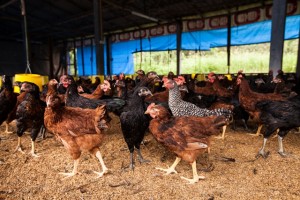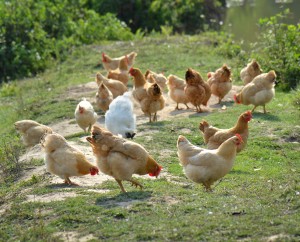Poultry Diseases
Bumblefoot
Also known as: Foot Lesions

Bumblefoot is most often associated with Staphylococcus infection, resulting in a large ball-like foot abscess
Long-standing erosions and other skin damage, such as cuts and abrasions, can predispose birds to a deeper infection of the foot pad, frequently referred to as bumblefoot. Of all the causes of foot pad lesions in poultry, the bumblefoot syndrome, with severe inflammation and swelling of the metatarsal foot pad, is regarded as the most severe type (Tauson and Abrahamsson, 1994). Bumblefoot is most often associated with Staphylococcus bacterial infection, which can result in a large ball-like foot abscess.
When infection occurs, synovial membranes in the joints and tendons of the hock and feet become thickened and edema is seen. Inflammation occurs, and a fluid may be produced around the joints and tendon sheaths. Wounds heal on the outside, but leave a hard core of pus in the inside. If the condition becomes chronic, fibrous tissue can form around the foot.
Infection in poultry by the bacterium Staphylococcus aureus can also cause swollen hock joints, resulting in lameness. This condition is normally associated with young broiler birds and usually occurs between 8 and 16 weeks.
Whilst bumblefoot is a potential problem in extensive organic and free range systems (Knierim, 2006), there are few reports recording the occurence and incidence. A small percentage of surveyed Swedish organic poultry farmers mentioned foot problems, mainly bumblefoot, but this only affected a small number of hens in the flocks (Berg, 2002).
Control and Prevention of Bumblefoot

Although it is expected that outdoor birds will suffer less bumblefoot than confined birds, there are additional risks. Care should be taken to ensure that all outdoor spaces are free of any materials that could puncture the foot, e.g. sharp rocks, stones and nails and other metal objects.
Although it may be expected that birds reared outdoors will suffer less than confined birds, there are also additional risks. Control should be based upon avoiding the predisposing and debilitating factors.
Wounds are an important point of entry for bacterial infection, and so it is important that any material that may puncture the feet of chickens should be minimized. For outdoor systems, this may mean sharp rocks and stones or nails and other metal objects.
Moisture, temperature and perch design are important contributing factors for the occurrence of foot pad dermatitis in laying hens. A European beech hardwood circular prototype perch with a flattened upper and lower surface has been shown to cause fewer problems than a traditional flat perch (Tauson and Abrahamsson, 1994). In addition, wet perches may contribute to the severity of such lesions (Wang et al, 1998).
Thermography has been identified as a potentially useful tool for screening bumblefoot in poultry, which in turn would improve recovery percentages and bird well-being (Wilcox et al., 2009).
Treating Bumblefoot
Although applying antibiotics may be effective, these are not always effective against advanced and chronic cases.
Applying slight pressure on the abscess can sometimes result in the abscess bursting and releasing pus. However, it may be necessary to lance the abscess with a sterile blade. The pus should be cleaned out and the wound treated with an antiseptic liquid or cream. It may be necessary to bind the wound with a sterile bandage.
Treatment procedure:
- Wash foot, open abscess, squeeze out core, clean with hydrogen peroxide, and wrap with gauze.
- Apply warm linseed meal poultice, lance wound, wash with hydrogen peroxide, and pack wound with gauze
- Apply tea tree oil to cracks
- Soak foot in Epsom salts.
Good Practice Based on Current Knowledge
- Do not keep poultry on excessively rocky/stony/flinty soils
- Eliminate all sharp objects that may cause foot injury from houses and range areas
- Ensure perches are well designed


 British English
British English

Comments are closed.